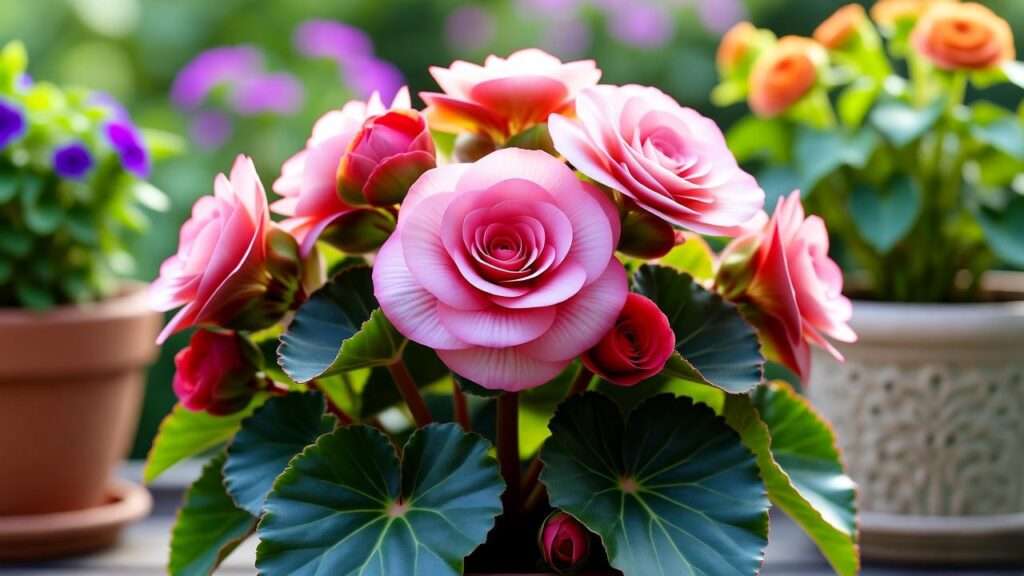Imagine a cascade of delicate pink blooms or shimmering pink-tinged foliage brightening your home or garden, stealing the show with minimal effort. That’s the magic of the begonia pink plant! Whether you’re a seasoned gardener or a newbie looking to add a splash of color, this versatile plant is your ticket to vibrant, eye-catching beauty. In this comprehensive guide, we’ll unlock the secrets to growing and caring for a begonia pink plant, ensuring stunning blooms and lush foliage year-round. With expert tips drawn from years of hands-on plant care experience, you’ll learn exactly how to nurture this stunner to thrive. Ready to transform your space? Let’s dive in! 🌺
1. Understanding the Begonia Pink Plant 🌼
1.1 What Is a Begonia Pink Plant?
The begonia pink plant refers to a variety of begonias known for their striking pink flowers or foliage, including popular species like Begonia rex (known for its colorful leaves) and Begonia tuberosa (prized for its vibrant blooms). These plants belong to the Begoniaceae family, boasting over 2,000 species and hybrids. Their hallmark? Lush, asymmetrical leaves and delicate pink flowers or foliage that range from soft blush to bold magenta. Compact and adaptable, they’re perfect for indoor pots, shaded garden beds, or hanging baskets.
Begonias are cherished for their versatility—thriving indoors or in shaded outdoor spaces—and their relatively low-maintenance nature. Whether you’re aiming for a pop of color in a dim corner or a statement piece on your patio, the begonia pink plant delivers.
1.2 Types of Begonia Pink Plants
Not all begonia pink plants are created equal! Here are some standout varieties to consider:
- Begonia ‘Pink Minx’: Known for its silvery-pink leaves with dark veins, ideal for indoor decor.
- Begonia ‘Flamingo’: Features vibrant pink flowers that resemble miniature roses, perfect for hanging baskets.
- Begonia rex hybrids: These showcase stunning pink-toned foliage with intricate patterns, a favorite for foliage lovers.
- Tuberous Begonias: Offer large, double pink blooms that rival peonies in shaded gardens.
| Variety | Light Needs | Bloom/Foliage Season | Best Use |
|---|---|---|---|
| Pink Minx | Low to bright indirect | Year-round (foliage) | Indoor pots |
| Flamingo | Bright indirect | Summer | Hanging baskets |
| Rex Hybrids | Low to medium indirect | Year-round (foliage) | Decorative displays |
| Tuberous Begonias | Partial shade | Summer to fall | Garden beds |
1.3 Why Choose a Begonia Pink Plant?
Why opt for a begonia pink plant? It’s a low-effort, high-impact choice! These plants thrive in shaded areas where other flowering plants struggle, making them ideal for north-facing rooms or under tree canopies. Their compact size suits small spaces, and their vibrant pink hues add instant charm. Plus, with proper care, they’re beginner-friendly, addressing the common pain point of wanting a beautiful plant without complex upkeep.
Expert Anecdote: As a plant enthusiast, I once revived a wilting Begonia ‘Flamingo’ by adjusting its light and humidity—within weeks, it was bursting with pink blooms that became the centerpiece of my living room! 🌟
2. Optimal Growing Conditions for Begonia Pink Plants ☀️
To unlock the full potential of your begonia pink plant, you need to nail its growing conditions. Let’s break it down.
2.1 Light Requirements
Begonia pink plants thrive in bright, indirect light. Too much direct sunlight can scorch their delicate leaves, while too little light dulls their colors and stunts blooms. For indoor plants, place them near east-facing windows or a few feet from south- or west-facing ones with sheer curtains. Outdoors, opt for shaded patios or spots under trees with dappled light.
Common Mistake: Placing begonias in direct sun. If you notice crispy leaf edges, move your plant to a shadier spot ASAP.
2.2 Temperature and Humidity
These plants love warmth and humidity, mimicking their tropical origins. Aim for:
- Temperature: 65–75°F (18–24°C). Avoid sudden drops below 60°F, as cold drafts can cause leaf drop.
- Humidity: 50–60% is ideal. Boost humidity with a pebble tray filled with water, a room humidifier, or by grouping plants together. In dry climates, misting leaves (sparingly) can help.
Pro Tip: If your home is dry, especially in winter, place a small humidifier near your begonia to keep it happy. 💧
2.3 Soil and Potting Needs
A well-draining, nutrient-rich soil mix is key. Combine:
- 50% peat-based potting mix
- 25% perlite or vermiculite for drainage
- 25% compost for nutrients
Choose a pot with drainage holes to prevent waterlogging, which can lead to root rot. For young plants, a 6–8-inch pot works well; repot every 1–2 years as they grow.
Visual Idea: An infographic summarizing light, temperature, and soil needs would make this section scannable and reader-friendly! 📊
3. Step-by-Step Care Guide for Begonia Pink Plants 🪴
Now that you know the ideal conditions, let’s dive into the daily care routine to keep your begonia pink plant thriving.
3.1 Watering Best Practices
Begonias prefer consistently moist soil but hate being soggy. Water when the top inch of soil feels dry—typically every 5–7 days indoors or more frequently in hot weather. Use room-temperature water and pour until it drains from the pot’s base, then empty the saucer to avoid standing water.
- Overwatering Signs: Yellowing leaves, mushy stems, or a musty smell.
- Underwatering Signs: Drooping leaves or dry, crispy edges.
- Seasonal Tip: Reduce watering in fall and winter when growth slows.
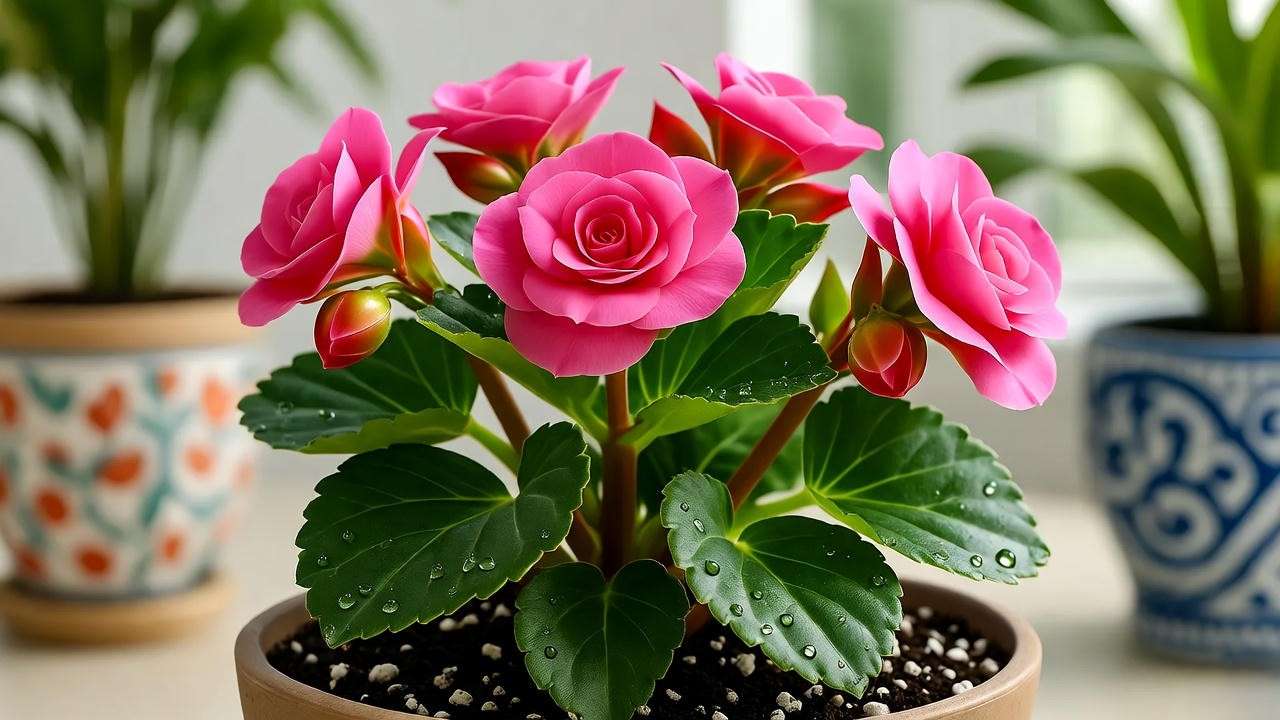
3.2 Fertilizing for Vibrant Blooms
Feed your begonia pink plant every 2–4 weeks during the growing season (spring and summer) with a balanced, water-soluble fertilizer (e.g., 10-10-10) or a bloom-boosting formula (e.g., 15-30-15). Dilute to half-strength to avoid burning roots. In fall and winter, stop fertilizing to let the plant rest.
Caution: Over-fertilizing can cause leaf burn or leggy growth. Always follow package instructions.
3.3 Pruning and Maintenance
Regular pruning keeps your begonia bushy and healthy:
- Remove Dead Material: Snip off yellowed leaves or spent flowers with clean scissors.
- Pinch for Growth: Pinch back stem tips to encourage branching and fuller growth.
- Clean Leaves: Wipe foliage with a damp cloth to remove dust and boost photosynthesis.
Case Study: A friend’s neglected Begonia rex was leggy and bloomless. After pruning dead leaves, adjusting light, and fertilizing monthly, it transformed into a vibrant showpiece within two months! 🌿
4. Propagating Begonia Pink Plants 🌱
Want more begonias for free? Propagation is easy and rewarding!
4.1 Methods of Propagation
- Leaf Cuttings:
- Select a healthy leaf, cut it with a clean blade, and place the cut end in water or moist soil.
- Roots should form in 2–4 weeks.
- Stem Cuttings:
- Cut a 4-inch stem with a few leaves, dip in rooting hormone (optional), and plant in a moist, well-draining mix.
- Keep in a warm, humid spot with indirect light.
- Division (Tuberous Begonias):
- In spring, divide tubers with a clean knife, ensuring each section has a bud.
- Plant in fresh soil and water sparingly until growth appears.
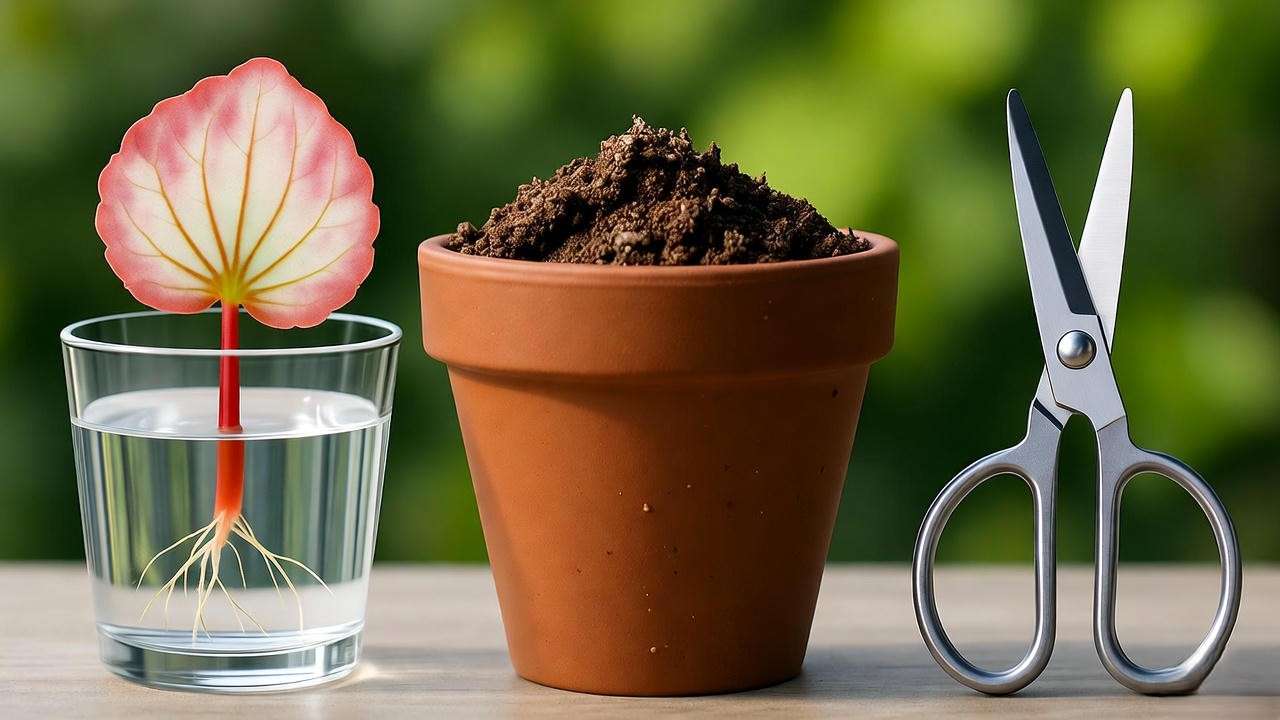
4.2 Tips for Successful Propagation
- Best Time: Spring or early summer for active growth.
- Tools: Sterilized scissors, small pots, and rooting hormone (optional).
- Pitfalls to Avoid: Overwatering cuttings or exposing them to direct sun, which can cause rot or stress.
Visual Idea: A step-by-step photo guide for leaf cuttings would make this section engaging and easy to follow. 📸
5. Common Problems and Solutions 🐞
Even with the best care, your begonia pink plant may face challenges. Here’s how to troubleshoot and keep it thriving.
5.1 Pests and Diseases
Begonia pink plants can attract a few pesky intruders, but early action keeps them at bay:
- Common Pests:
- Aphids: Tiny green or black insects that suck sap, causing curled leaves. Rinse them off with water or apply neem oil weekly.
- Spider Mites: Look for webbing and stippled leaves. Increase humidity and spray with insecticidal soap.
- Mealybugs: White, cottony masses on stems or leaf joints. Dab with alcohol-soaked cotton swabs or use neem oil.
- Fungal Diseases:
- Powdery Mildew: White, powdery spots on leaves. Improve air circulation and apply a fungicide if needed.
- Botrytis (Gray Mold): Grayish fuzz on leaves or flowers, often in humid conditions. Remove affected parts and reduce watering.
Pro Tip: Regularly inspect your plant’s undersides of leaves, where pests love to hide. Early detection is key! 🔍
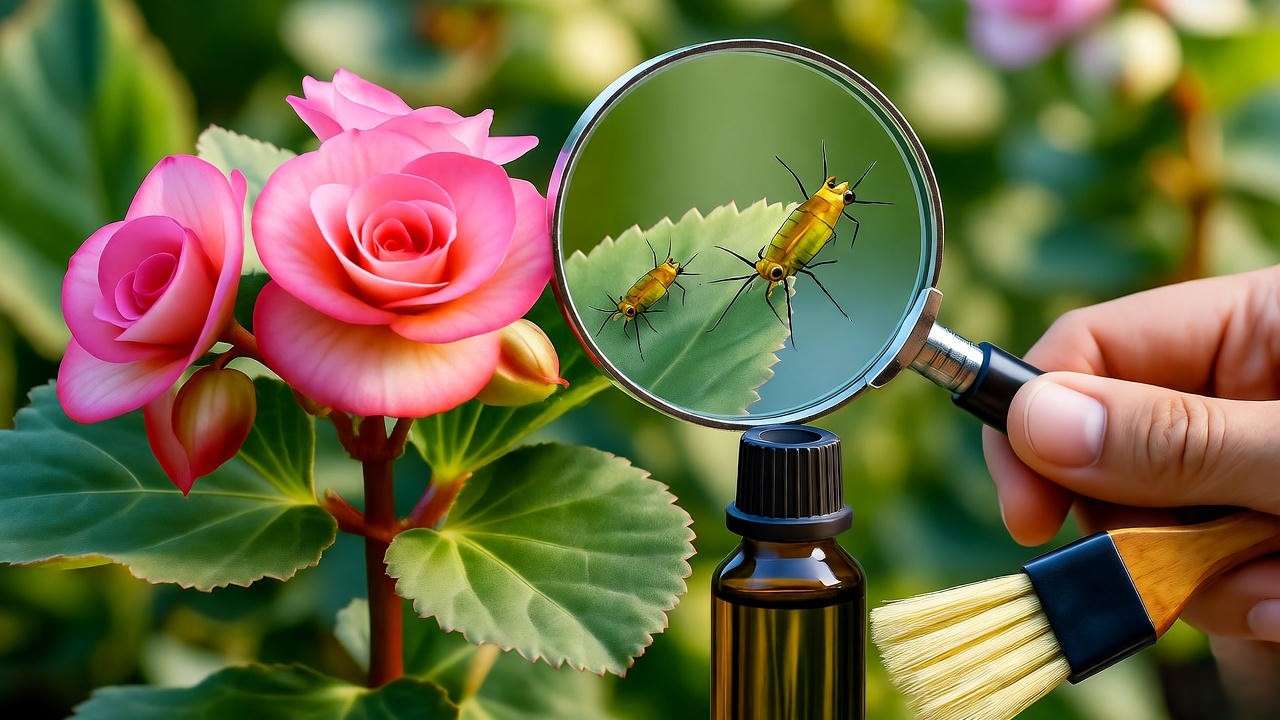
5.2 Troubleshooting Growth Issues
Is your begonia pink plant looking less than vibrant? Here’s how to diagnose and fix common issues:
- Yellowing Leaves: Often caused by overwatering, poor drainage, or nutrient deficiency. Check soil moisture, ensure proper drainage, and fertilize if needed.
- Lack of Blooms: Insufficient light or improper feeding could be the culprit. Move to brighter indirect light and use a bloom-boosting fertilizer (e.g., 15-30-15).
- Wilting or Drooping: This may indicate root rot (from overwatering) or temperature stress. Inspect roots for mushiness; if healthy, adjust watering or move to a warmer spot.
Reader Tool: A troubleshooting checklist can help you quickly pinpoint issues:
- Yellow leaves? Check watering and drainage.
- No blooms? Increase light and fertilize.
- Drooping? Assess roots and temperature.
6. Designing with Begonia Pink Plants in Your Space 🎨
The begonia pink plant’s vibrant hues make it a design superstar. Here’s how to showcase it indoors and outdoors.
6.1 Indoor Decor Ideas
Begonia pink plants are perfect for adding color to your home:
- Containers: Place in decorative ceramic pots on coffee tables or windowsills for a pop of pink.
- Terrariums: Use compact varieties like Begonia rex in glass enclosures for a mini jungle vibe.
- Hanging Baskets: Trailing types like Begonia ‘Flamingo’ look stunning in macramé hangers.
- Plant Pairings: Combine with ferns, calatheas, or pothos for a lush, tropical display.
Design Tip: Place your begonia in a humid spot like a bathroom with indirect light for both aesthetics and health. 🛁
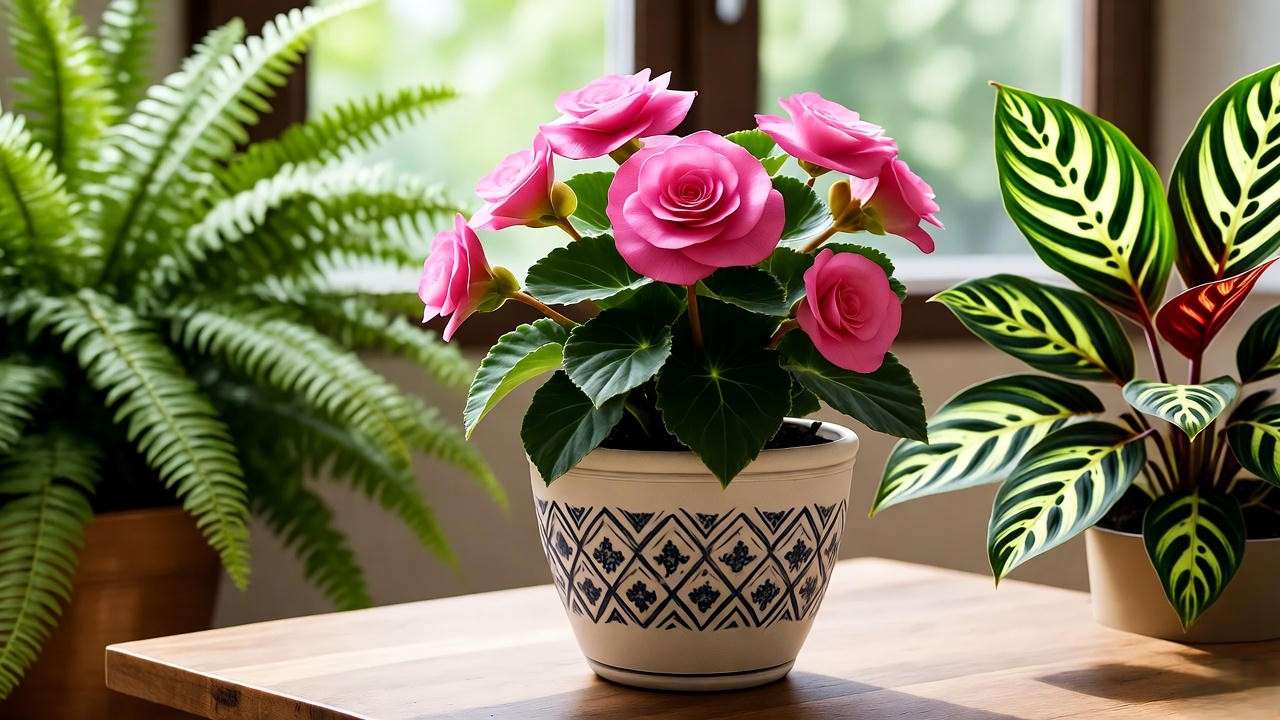
6.2 Outdoor Garden Integration
Outdoors, begonia pink plants shine in shaded areas:
- Shaded Borders: Use tuberous begonias along garden edges for bursts of pink blooms.
- Patio Containers: Mix with impatiens or coleus for vibrant planters.
- Companion Plants: Pair with hostas or shade-loving ferns for a cohesive look.
- Climate Considerations: In cooler climates, bring potted begonias indoors before frost.
Inspiration Gallery: Encourage readers to share photos of their begonia displays on social media with a hashtag like #BegoniaPinkGoals to boost engagement. 📷
7. Seasonal Care Tips for Year-Round Success ❄️☀️
To keep your begonia pink plant thriving through every season, adjust care routines as follows.
7.1 Spring and Summer Care
This is the active growth period for begonias:
- Watering: Keep soil consistently moist, checking every 5–7 days.
- Fertilizing: Feed every 2–4 weeks with a balanced fertilizer to support blooms and foliage.
- Pest Monitoring: Warm weather can attract pests like aphids. Inspect weekly and treat promptly.
- Pruning: Pinch back stems to encourage bushier growth and remove spent flowers.
7.2 Fall and Winter Care
As growth slows, your begonia needs less attention:
- Watering: Reduce to every 10–14 days, allowing the top inch of soil to dry out.
- Fertilizing: Stop fertilizing to let the plant rest.
- Humidity: Combat dry indoor air with a humidifier or pebble tray.
- Overwintering Tuberous Begonias: Dig up tubers after foliage dies back, store in dry peat moss at 45–50°F (7–10°C), and replant in spring.
Seasonal Care Calendar:
- Spring: Fertilize, propagate, and repot.
- Summer: Water regularly, prune, and monitor pests.
- Fall: Reduce watering and prepare for dormancy.
- Winter: Minimize care and protect from cold.
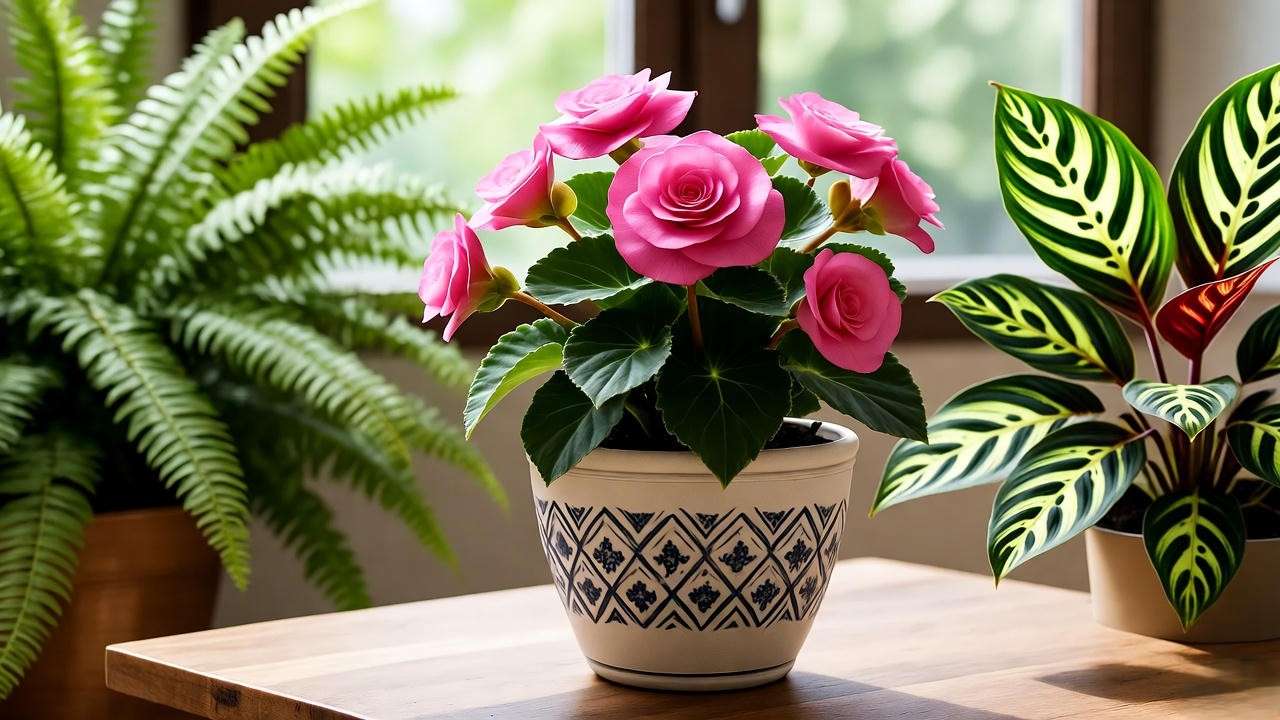
8. FAQs About Begonia Pink Plant Care ❓
Here are answers to common questions to help you succeed:
Q: Why aren’t my begonia pink plant’s flowers blooming?
A: Lack of blooms often stems from insufficient light or nutrients. Ensure bright, indirect light and feed with a bloom-boosting fertilizer (15-30-15) every 2–4 weeks during spring and summer.
Q: Can begonia pink plants grow in low light?
A: Some varieties, like Begonia rex, tolerate low light but may lose vibrancy. For best results, provide medium to bright indirect light.
Q: How do I revive a drooping begonia pink plant?
A: Check for overwatering or root rot. Trim damaged roots, repot in fresh soil, and adjust watering to keep soil moist but not soggy.
Q: Are begonia pink plants pet-safe?
A: Begonias are mildly toxic to cats and dogs, causing vomiting if ingested. Keep out of reach of pets.
Q: How often should I repot my begonia pink plant?
A: Repot every 1–2 years or when roots outgrow the pot. Spring is the best time for repotting.
9. Conclusion: Your Path to a Thriving Begonia Pink Plant 🌟
Growing a vibrant begonia pink plant is easier than you think! By providing bright, indirect light, maintaining moist soil, and following a seasonal care routine, you’ll enjoy stunning pink blooms or foliage that elevate any space. Whether you’re propagating new plants or designing a lush indoor display, this guide equips you with expert-backed strategies to succeed. Have a begonia pink plant success story? Share it in the comments or on social media with #BegoniaPinkGoals! Ready to explore more? Check out our guides on “Top 10 Indoor Plants for Low Light” or “Caring for Tuberous Begonias” for more plant inspiration. 🌱

